
Category Archives: events
FranceRelance : feuille de route pour l’adaptation des forêts au changement climatique
Depuis plusieurs années, sous l’effet du changement climatique, la forêt française fait face à des risques naturels sévères et croissants, comme la sècheresse, les vagues de chaleur ou les inondations, mais également à des risques sanitaires biotiques (invasion de scolytes, chenilles processionnaires, chalarose) engendrant des dépérissements importants dans de nombreux massifs forestiers. Depuis sa création, les partenaires du Labex ARBRE développent des programmes de recherche visant à adapter la forêt à ces évolutions du climat et la rendre plus résiliente.
Mardi 22 décembre 2020, les acteurs de la filière forêt-bois ont remis au ministre de l’Agriculture et de l’Alimentation leur feuille de route pour l’adaptation des forêts au changement climatique, dont les orientations ont largement inspiré le volet forestier du plan national de relance résultant de l’épidémie de Covid-19. Le ministre a signé avec eux une charte d’engagement pour la réussite du plan de relance et a annoncé le lancement de nouveaux dispositifs. Les acteurs de la filière Forêts-Bois se retrouvent autour de 9 priorités dont plusieurs recoupent les priorités stratégiques du LabEx ARBRE :
– renforcer la coopération scientifique et les connaissances pour l’adaptation des forêts et de la filière forêt-bois au changement climatique ;
– diffuser et s’approprier les connaissances acquises, développer et centraliser les outils de diagnostic et d’aide à la décision face aux risques climatiques pour l’adaptation ;
– promouvoir les pratiques sylvicoles qui augmentent la résilience, diminuent les risques et limitent l’impact des crises ;
– mobiliser les outils financiers permettant aux propriétaires d’investir pour adapter leurs forêts ;
– conforter la veille et le suivi sanitaire, organiser la gestion de crises ;
– renforcer et étendre les dispositifs de prévention et de lutte contre les risques abiotiques, et notamment la défense contre les incendies (DFCI) ;
– préparer et accompagner l’adaptation de l’amont de la filière, en développant une solidarité élargie de filière pour être en mesure de préparer les ressources forestières futures ;
– préparer et accompagner l’adaptation des entreprises de l’aval de la filière ;
– renforcer le dialogue et la concertation, développer l’animation et la médiation entre acteurs au sein des territoires.
En remettant cette feuille de route, les acteurs de la forêt et de la filière forêt-bois marquent leurs souhaits de relever ce défi en s’engageant sur des actions et des moyens néces- saires à l’adaptation des forêts et de la filière au changement climatique.
Pour en savoir plus …
- Feuille de route pour l’adaptation des forêts au changement climatique (PDF, 206.8 Ko)
- Charte d’engagement entre l’État et les acteurs de la filière forêt-bois (PDF, 74.34 Ko)
- Dossier de presse – Le ministre de l’Agriculture et de l’Alimentation et l’ensemble des acteurs de la filière s’engagent pour l’adaptation des forêts au changement climatique (PDF, 1.21 Mo)
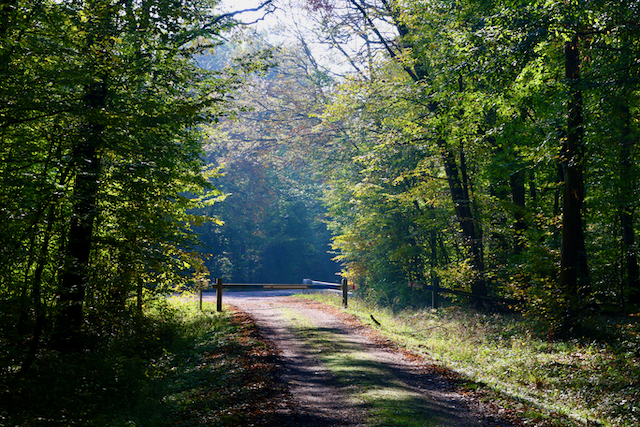
Semaine de la recherche
La forêt et le bois sont des sujets pour la science … ou le LABEX ARBRE raconté aux étudiants pour la semaine de la science 2021
(cliquez sur les zones en gras (liens hypertexte) pour avoir des précisions)
Les forêts sont traditionnellement des zones de chasse, de cueillette et de parcours, et sont souvent appropriées comme des biens communautaires. Depuis toujours, elles produisent du bois, matière première pour l’habitat, l’énergie, la culture (le papier ou les instruments de musique …), dont le besoin ne cesse d’augmenter, pour une industrie lourde qui co-existe avec l’artisanat. On demande aujourd’hui toujours plus de services à nos forêts pour héberger la biodiversité, pour séquestrer le CO2 en atténuation du changement climatique, pour améliorer la qualité de l’eau ou de l’air, pour préserver les sols ou limiter l’érosion, et tout simplement pour satisfaire le besoin de nature et de rêves de citoyens de plus en plus urbains. Mais ces forêts sont aussi des écosystèmes fragiles qui peuvent disparaître sous le feu, le vent, les sécheresses ou les pathogènes. Elles représentent également des risques pour l’environnement et nos activités, en hébergeant par exemple des vecteurs de maladies.
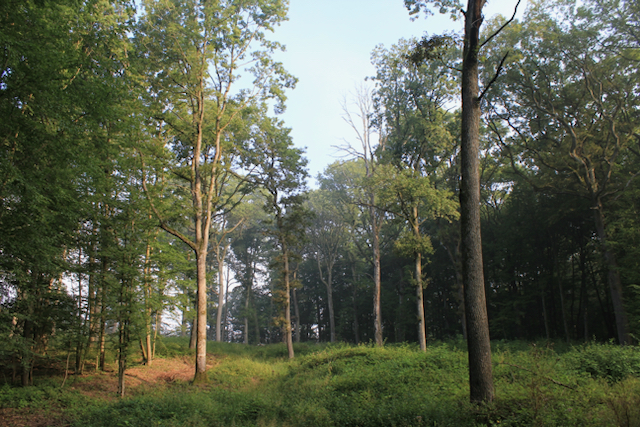
Dans les paysages européens façonnés par l’homme depuis l’Antiquité, les forêts ne sont pas vraiment des ressources naturelles – car contrairement à l’air ou l’eau, elles ne proviennent pas de la nature de manière directe sans intervention humaine. Pour autant, leur sylviculture ne transforme pas autant le milieu naturel que l’agriculture. Les forêts sont sources de quantité de services et d’emplois (les forêts et la filière bois représentent 450 000 emplois en France, dans le même ordre de grandeur que l’agroalimentaire).
A Nancy, s’est développé depuis de nombreuses années un dispositif de formation et de recherche sur les forêts et les services qu’elles procurent, notamment le bois utilisé comme matériau de construction mais aussi source d’énergie et de biomolécules. Ce dispositif est reconnu depuis 2012 par le Laboratoire d’Excellence ARBRE qui fédère une diversité de laboratoires et d’organismes lorrains et développe des recherches de pointe dans de nombreuses disciplines : écologie mais aussi microbiologie, physiologie, économie, génie des procédés ou chimie.
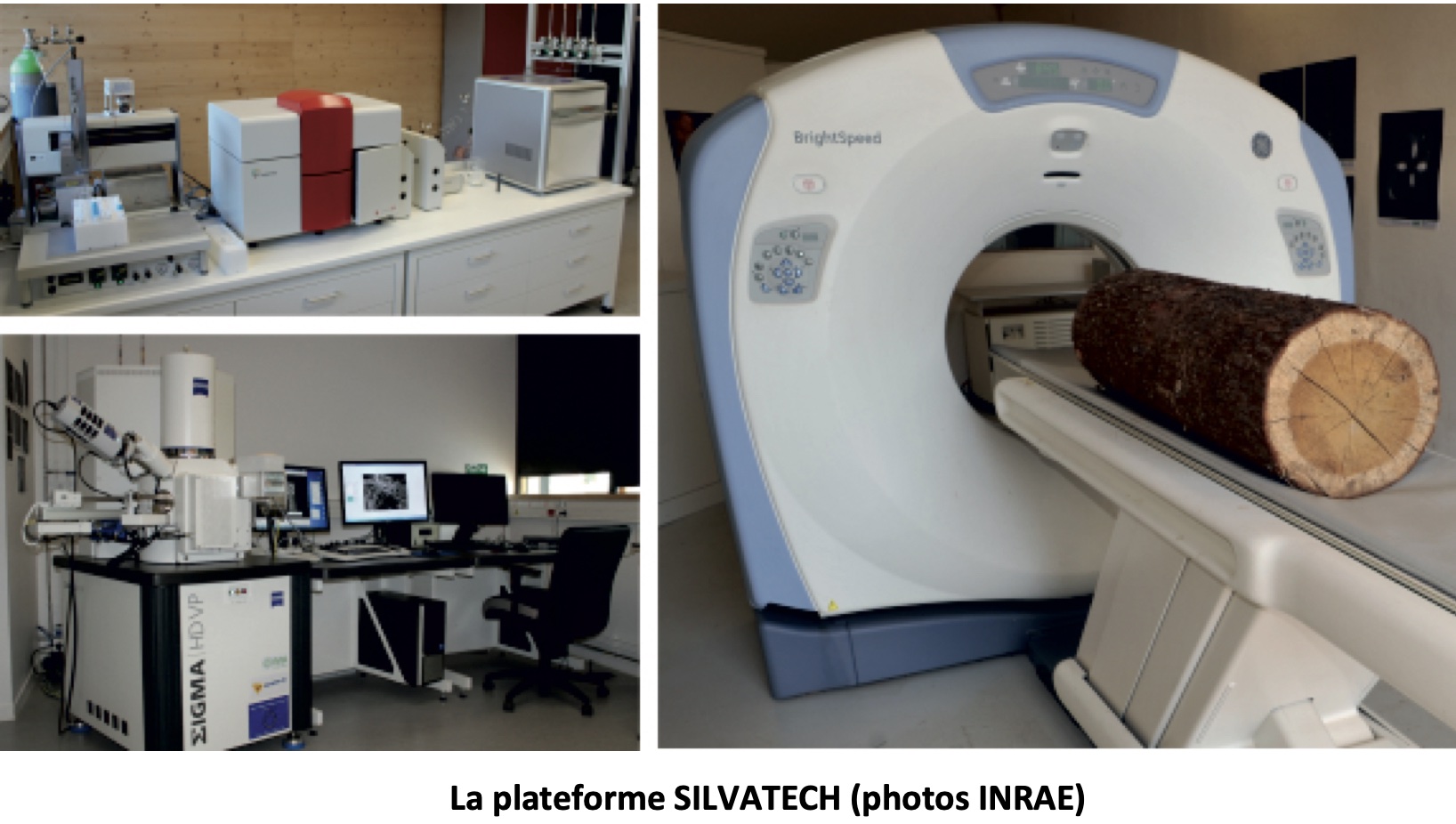
Les travaux de ces laboratoires vont de la recherche la plus fondamentale notamment sur l’écologie évolutive des interactions entre arbres et champignons symbiotiques ou pathogènes, à des projets très appliqués, jusqu’à l’innovation la plus ambitieuse conduite avec les entreprises qui gèrent les forêts. Une forte originalité de la recherche forestière est de devoir composer avec l’observation de systèmes très lents – arbres et forêts- en conditions naturelles ce qui demande de développer un savoir-faire expérimental sur des sites d’observation ou d’expérimentation sur le terrain. Depuis 2019, la succession d’années sèches a initié de graves mortalité des arbres, mettant sur le devant de la scène des recherches que nous conduisons depuis longtemps pour adapter la forêts aux climats du futur. Les stratégies nouvelles pour la bioéconomie stimulent également de nouveaux projets de recherche, par exemple sur le bois source de molécules ou le rôle des forêts et du bois dans le développement territorial. Mais nos recherches concernent aussi des domaines que vous ne soupçonnez sans doute même pas : biomécanique des arbres, écologie historique, économie des fonctions récréatives des forêts …
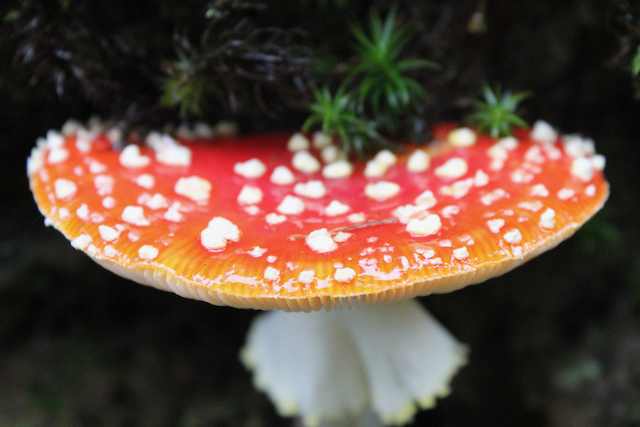
Pour en savoir plus :
Une synthèse d’une entreprise partenaire, l’Office National des Forêts, sur ses besoins de recherche et ses projets d’innovation pour construire les forêts du futur.
Quelques sites web – RENECOFOR , REGEBLOC – et une conférence qui présentent les méthodes et sites d’observation et d’expérimentation en forêt.
Un article de base sur la fertilité des sols en forêt.
Un site de projet pluridisciplinaire sur l’économie de la forêt dans le PNR des Ballons des Vosges.
Les productions remarquables de « Ma thèse en 180 secondes » #MT180 qui ont concerné nos recherches :
- sur l’adaptation des forêts aux sécheresses (Silva)
- sur la protection de la biodiversité forestière (Silva)
- sur la simulation macroécologique des forêts françaises (LIF, Silva)
- sur les champignons décomposeurs du bois (IAM)
- sur les pratiques du changement dans les organisations forestières (CEREFIGE Silva)
- sur la valorisation de la biomasse ligneuse (LERMaB)
A propos de nos travaux sur les champignons forestiers, deux courtes présentations de vulgarisation par INRAE (vidéos 1 et 2), et deux vidéos générales (vidéos 1 et 2) par Francis Martin (un des tous meilleurs chercheurs du monde pour la citation de ses articles scientifiques mais aussi un excellent vulgarisateur)
Quelques articles de vulgarisation de nos recherches « inattendues » :
- sur la biomécanique des arbres
- sur l’écologie historique des forêts
- sur l’économie de la valeur récréative des forêts
Et n’hésitez surtout pas à voir ou revoir l’excellent documentaire d’Emmanuelle Nobécourt sur le Génie des Arbres (malheureusement plus disponible en intégralité sur France TV).
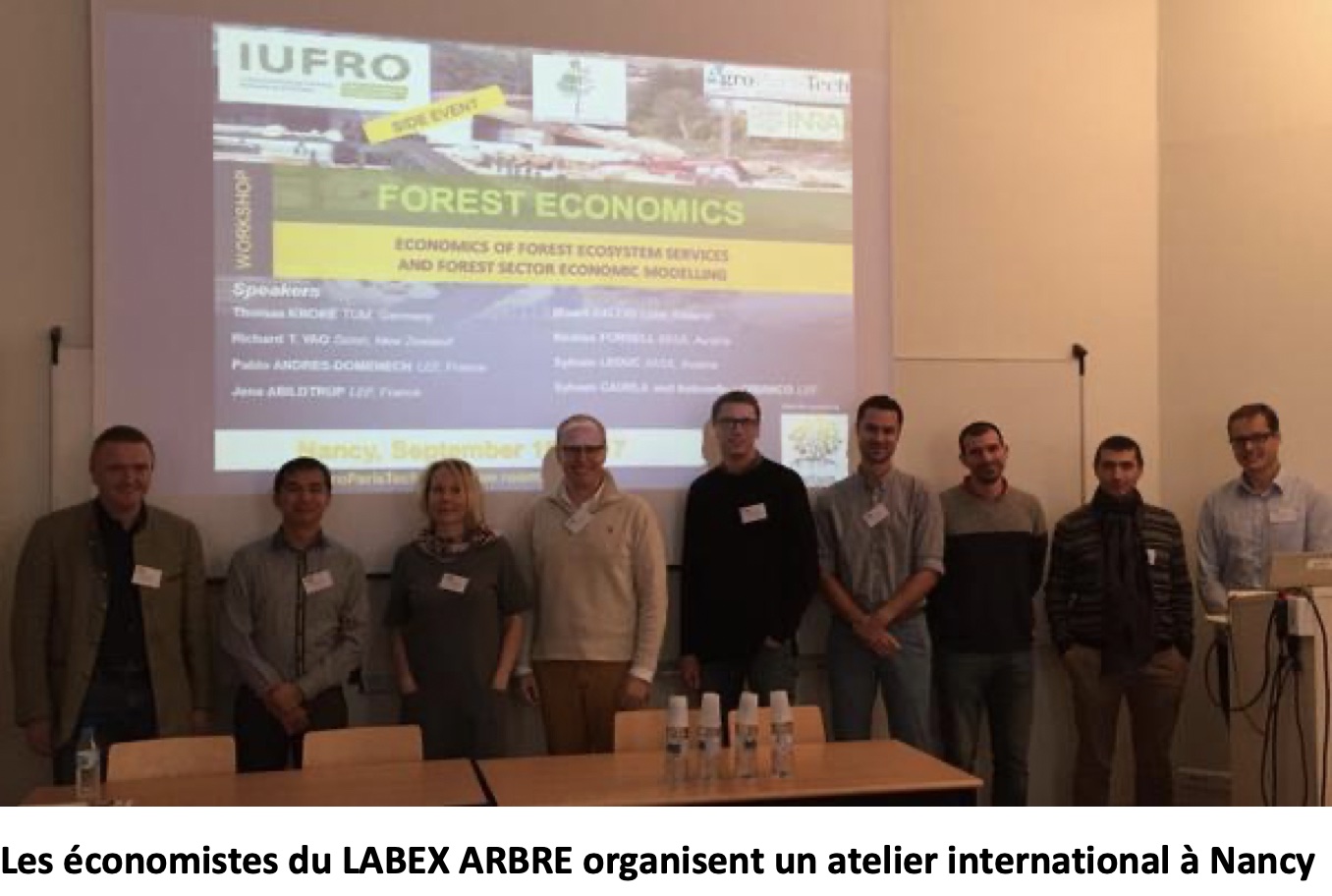
Mixing beech with fir or pubescent oak does not help mitigate drought exposure at the limit of its climatic range
In the context of climate change, it remains unclear whether mixed-species forests will help mitigate the impacts of future droughts and, if so, through which processes. As European beech (Fagus sylvatica L.) is one of the major European species, it is crucial to evaluate its response to drought when mixed with species with contrasted functional traits and in contrasted climatic conditions, particularly at the limit of its climatic range.
In a recent paper entitled “Mixing beech with fir or pubescent oak does not help mitigate drought exposure at the limit of its climatic range” published in Forest Ecology & Management, Soline Martin-Blangy and her collaborators (UMR Silva, UMR ISPA, UMR Biogeco, UMR CEFE) aimed to (i) characterize the effects of tree species interactions on the drought exposure of beech in south-eastern France, and (ii) determine whether belowground water uptake complementarity underlies these effects.
They focused on beech-silver fir (Abies alba Mill.) and beech-pubescent oak (Quercus pubescens Willd.) forests across six sites in the French pre-Alps, a region at the limit of the climatic range for beech. They used a triplet approach to compare the tree-ring carbon isotope composition (δ13C) of these species in pure and two-species mixed stands during a period of dry years, and used water hydrogen isotope composition (δ2H) in the xylem to identify water uptake sources. Overall, they found no clear mixture effect pattern on beech physiological functioning among sites and triplets. In beech-fir sites, mixing beech with fir had no effect on beech δ13C values during dry years. In beech-oak sites, mixture effects on beech were mostly neutral, although sometimes beech suffered from a stronger exposure to drought in mixed stands.
This study emphasizes the impact of the tree sampling design on the outcome of studies on forest biodiversity-ecosystem functioning relationships. Limiting tree sampling to dominant trees when analyzing stand-level relationships may bias these outcomes. The authors evidenced differences in water uptake sources between beech and fir, but not between beech and oak during a dry summer. However, these patterns did not help explain the lack of species mixture effects, or existence thereof, at the triplet scale. This study demonstrates that managing beech in mixed stands with silver fir or pubescent oak at the limit of beech climatic range does not buffer drought impacts on beech during dry years. In the long term, with more frequent extreme droughts, promoting beech-fir mixtures will not be detrimental to beech drought response, while beech may suffer in mixtures with pubescent oak.
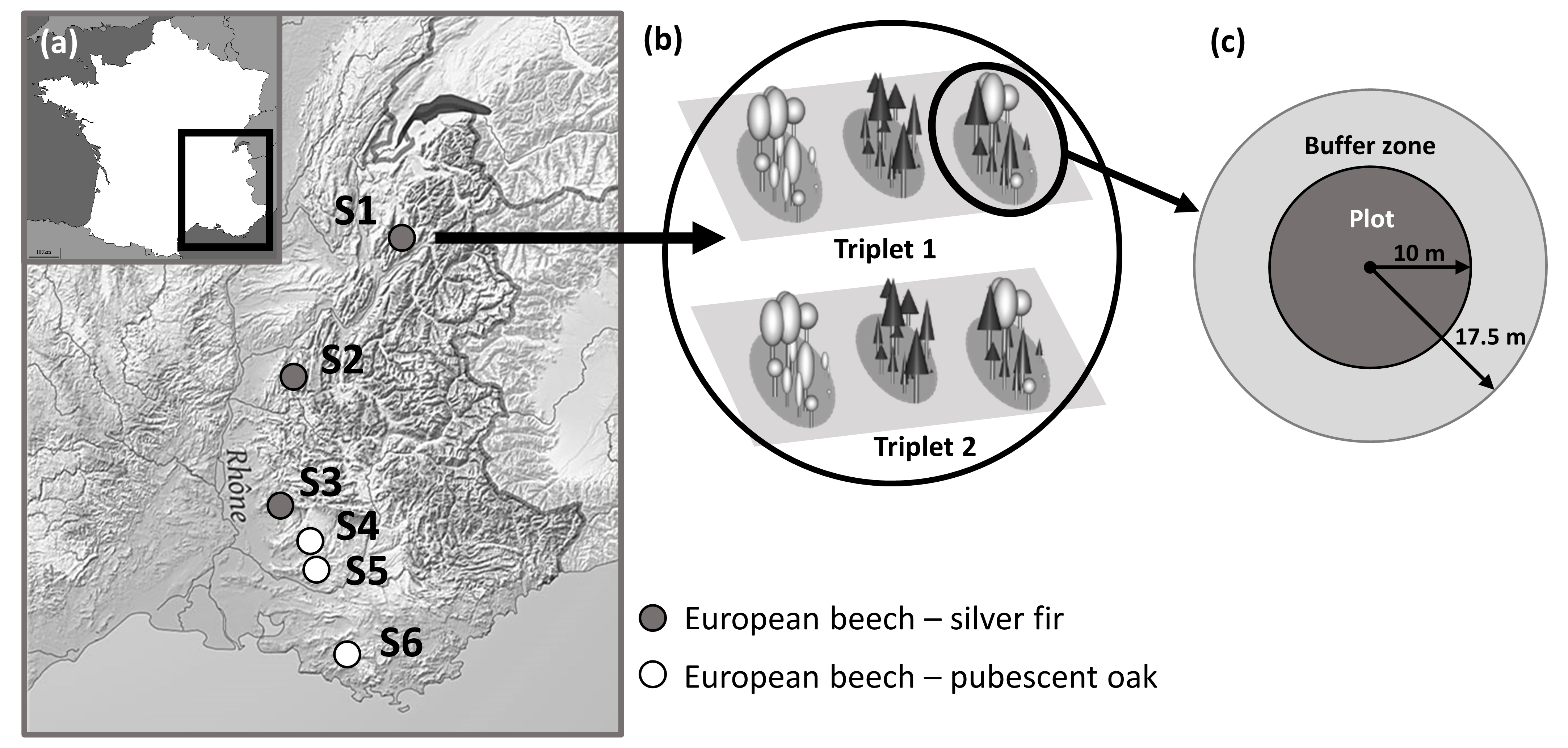
The variability of leaf phenology among regional beech
A new paper entitled ‘Leafy season length is reduced by a prolonged soil water deficit but not by repeated defoliation in beech trees (Fagus sylvatica L.): comparison of response among regional populations grown in a common garden‘ has been published by Massonnet et al. (SILVA Department) has been published in Agricultural and Forest Meteorology.
Abstract. Bud-burst and leaf-senescence determine the length of the growing season for deciduous trees and therefore the duration of potential carbon assimilation with consequences on biomass production. In Fagus sylvatica L., leaf phenology depends on both photoperiod and temperature. The future climate is expected to induce more frequent soil water deficits and biotic attacks (possibly resulting in severe defoliation).
The aim of the present study is to assess whether these constrains may alter leaf phenology. In a common garden, we sowed seeds collected from six beech forests along a small latitudinal gradient (140 km) in North-Eastern France. In 2014, after seven years growth, a rain exclusion was installed above the trees to test how recurrent soil water deficits impacted bud-burst (BB) and leaf-yellowing (LY) over three years. We also analyzed the response of leaf phenology to annual defoliation, aiming at affecting carbon and nitrogen availability in trees.
Delayed BB and early LY were observed, reducing the growing season (GS) until 14 days in response to soil water deficit whereas no influence of defoliation was detected. These time lags were not in relation with leaf nitrogen content. In the control treatment, BB occurred earlier and LY later in the northernmost populations than in the southernmost without clear relationships with local climate. A significant treatment x population interaction was observed revealing a plasticity in the leaf phenology response to soil water deficit among populations.
These results suggest that beech trees present a genetic differentiation of leaf phenology even within a small latitudinal gradient but that these differentiations could be disrupted by soil water deficit that is predicted to increase in the future.
The experiment and operating costs were funded by the LabEx ARBRE within the framework of the Mepib-Death project. Pierre-Antoine Chuste received a PhD grant from ARBRE.
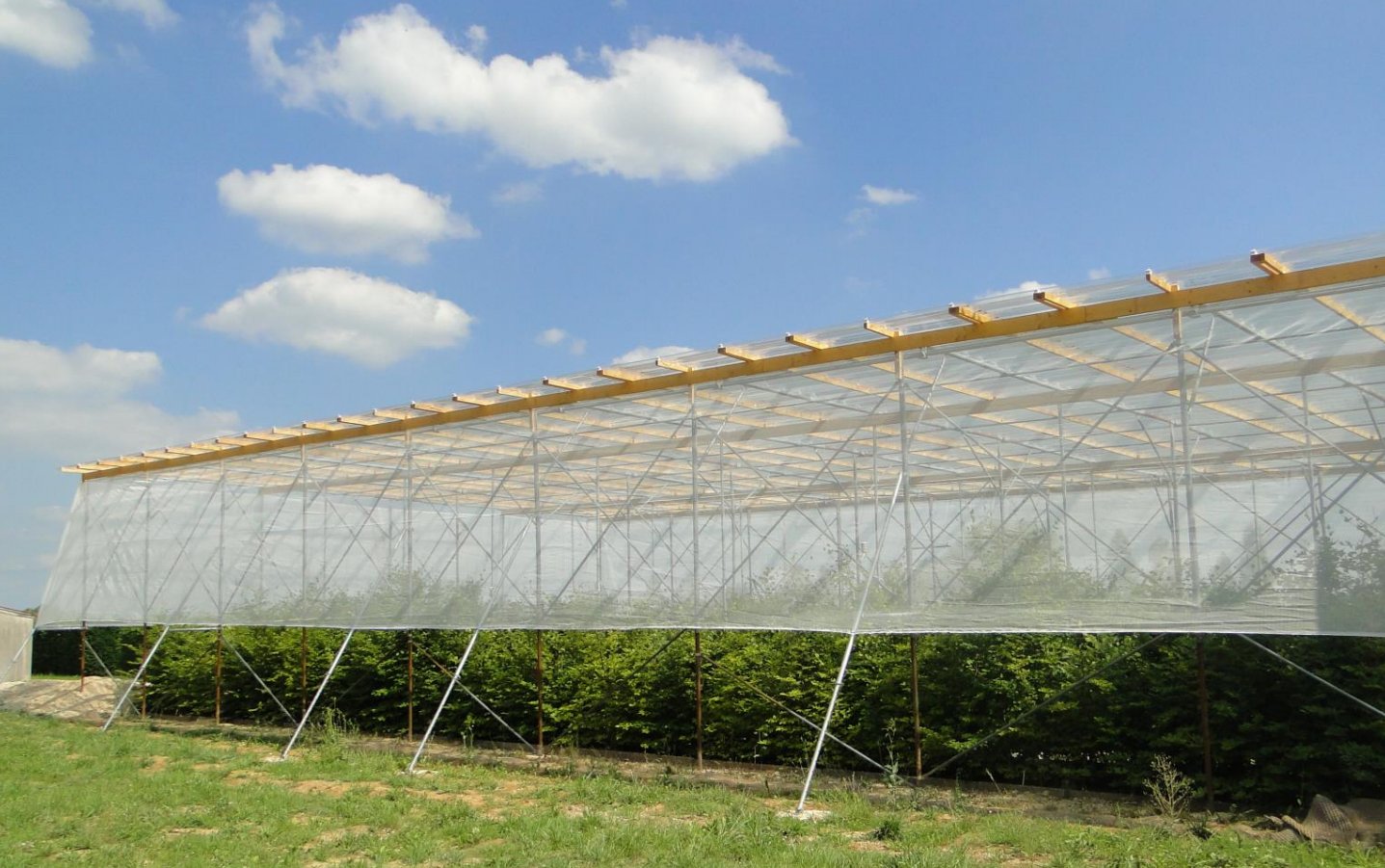
Large-scale genomics sheds light on the evolutionary history of mutualistic forest-dwelling fungi
Mutualistic fungi, known as mycorrhizae, play a major role in terrestrial ecosystems because they help plants acquire nutrients. However, how these fungi became symbionts was a mystery until now. Answers to this question have been provided by an international research consortium coordinated by INRAE and the Joint Genome Institute (US Department of Energy) to which the University of Lorraine and CNRS also contributed. The group analysed the genomes of 135 species of forest-dwelling fungi. The study’s results clarify how fungi living as decomposers became plant symbionts over the course of evolution. These findings were published on October 12 in Nature Communications.
Fungi display a variety of modes of nutrition (i.e. lifestyles): some are pathogens that parasitize living organisms, some are saprotrophs that exploit decomposing organic matter, and yet others are mycorrhizae that form beneficial symbioses with plants. More specifically, the plant roots and fungi engage in a mutualistic relationship that benefits them both. The mycorrhizae help the plants absorb essential minerals, such as nitrogen and phosphorus, promoting growth. The plants provide the mycorrhizal fungi with sugars and favourable environmental conditions. This mutualism has allowed plants to colonise most terrestrial habitats. To understand the evolutionary emergence of symbiotic traits in forest-dwelling fungi, the research consortium compared the functional traits encoded by the genomes of 135 fungal species, including 62 species of mycorrhizal fungi. Notably, the researchers sequenced and analysed, for the first time, the genomes of 29 symbiotic fungal species belonging to taxonomic orders like Russulales and Cantharellales; these taxa are important keystone species in temperate forest ecosystems.
The study revealed that, over evolutionary time, forest fungi transitioned multiple times from sapotrophic to symbiotic lifestyles. These transitions were accompanied by a loss of the genes that encode plant-cell-wall-degrading enzymes (such as cellulases and lignin-modifying enzymes). Other genes (e.g., sugar and amino acid transporters) are conserved in saprotrophic ancestors, but have been recruited for new symbiotic functions. Finally, several symbiosis-specific genes involved in fungus-plant communication were created de novo.
These transitional patterns were observed in all the families of ectomycorrhizal fungi1 belonging to the phyla Basidiomycota and Ascomycota2 (which represent 20,000 species). This finding provides a striking example of recurrent convergent evolution3 taking place over a time span of more than 100 million years. The researchers also discovered a few “hybrid” fungi—species that are still capable of decomposing organic matter but that can also live in symbiosis within the roots of their host plants. In these species, the genes encoding plant cell-wall-degrading enzymes are still present. However, they are not expressed when the fungi live as symbionts. It is possible that these species illustrate the first steps towards strict symbiosis.
This study has considerably increased the genomic resources available for studying the mechanisms underlying the development and function of mycorrhizal symbioses. In addition to clarifying the evolutionary history of forest-dwelling fungi, these discoveries will facilitate future studies examining how fungal communities in forest ecosystems could deal with climate change.
[1]Ectomycorrhizal fungi colonise the roots of plants. They live in symbiosis with their hosts, helping the latter absorb minerals.
[2]Basidiomycota and Ascomycota are two fungus phyla. Species in Basidiomycota form spores on the outside of specialised cells called basidia; mushroom-forming fungi are the most emblematic members of this taxon. Species in Ascomycota form spores within specialised cells called asci; commonly recognised members of this taxon are the morels, truffles, and yeasts.
[3]Convergent evolution is a process whereby different species that experience the same environmental constraints evolve similar adaptive responses. In this case, ectomycorrhizal symbiosis is that convergent response.
| Reference |
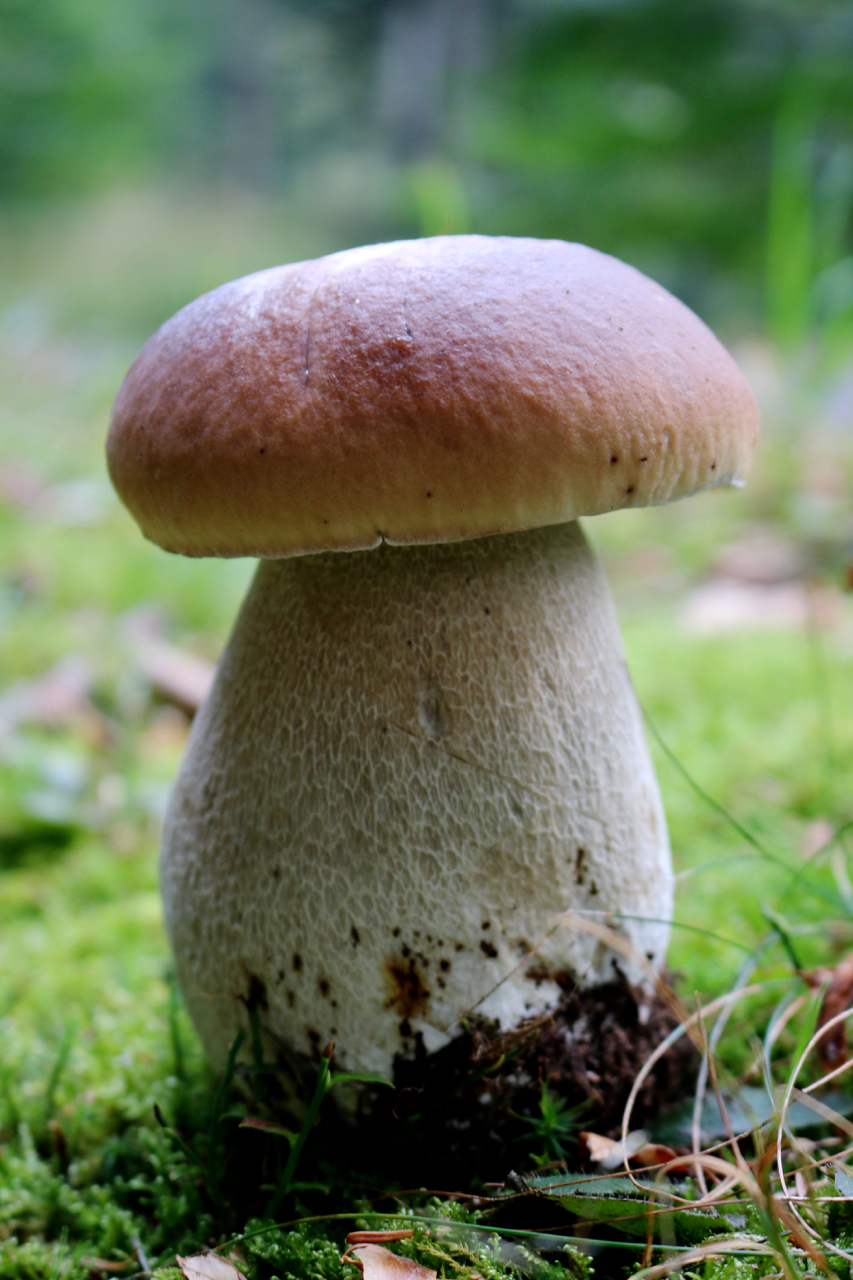
Le Génie des Arbres
Le génie des arbres, un documentaire diffusé lors de la soirée Science Grand Format du jeudi 15 mai à 20h50 sur France 5 – avec plusieurs interventions des équipes du LabEx ARBRE …

Annual Meeting of the Labex ARBRE
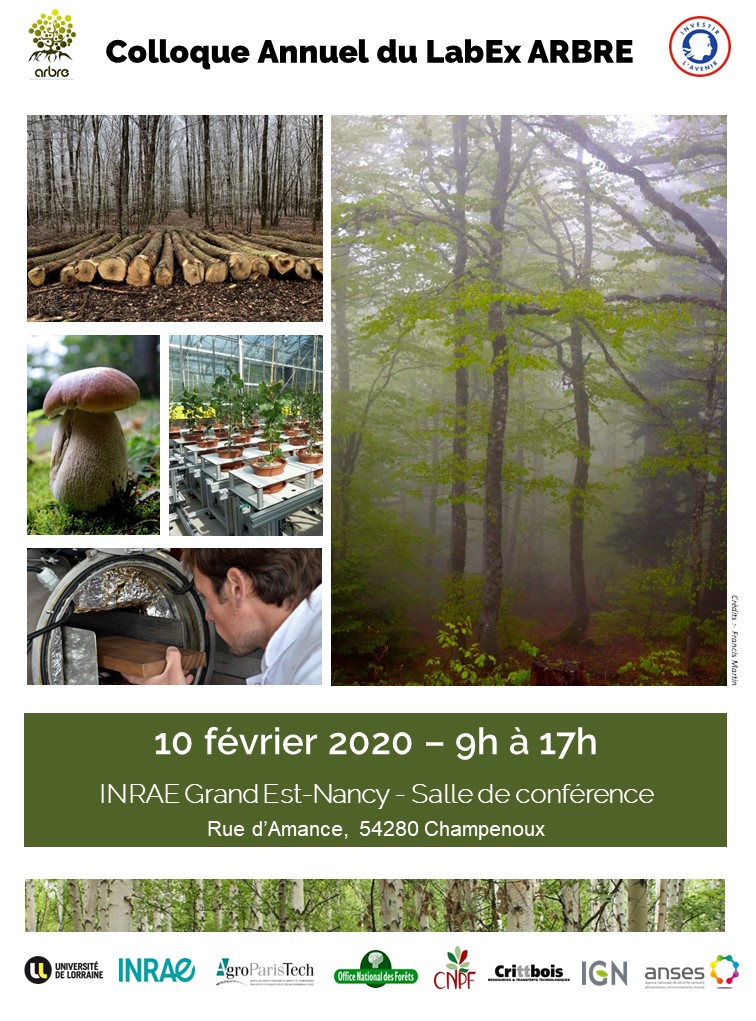 Registration is obligatory via this web link: Registration to the Labex Arbre annual meeting
Registration is obligatory via this web link: Registration to the Labex Arbre annual meeting
Conférence internationale Historical Ecology for the Future HEF 2020

Site internet de l’évènement : https://symposium.inra.fr/hef2020/
Soutenance HdR
Cyrille Rathgeber soutiendra son habilitation à diriger des recherches (HdR) intitulée :
“Écophysiologie de la Formation du Bois : Concepts, Méthodes et Applications”
jeudi 5 septembre 2019 à partir de 14h00
Salle de conférence du Centre Inra Grand Est-Nancy




